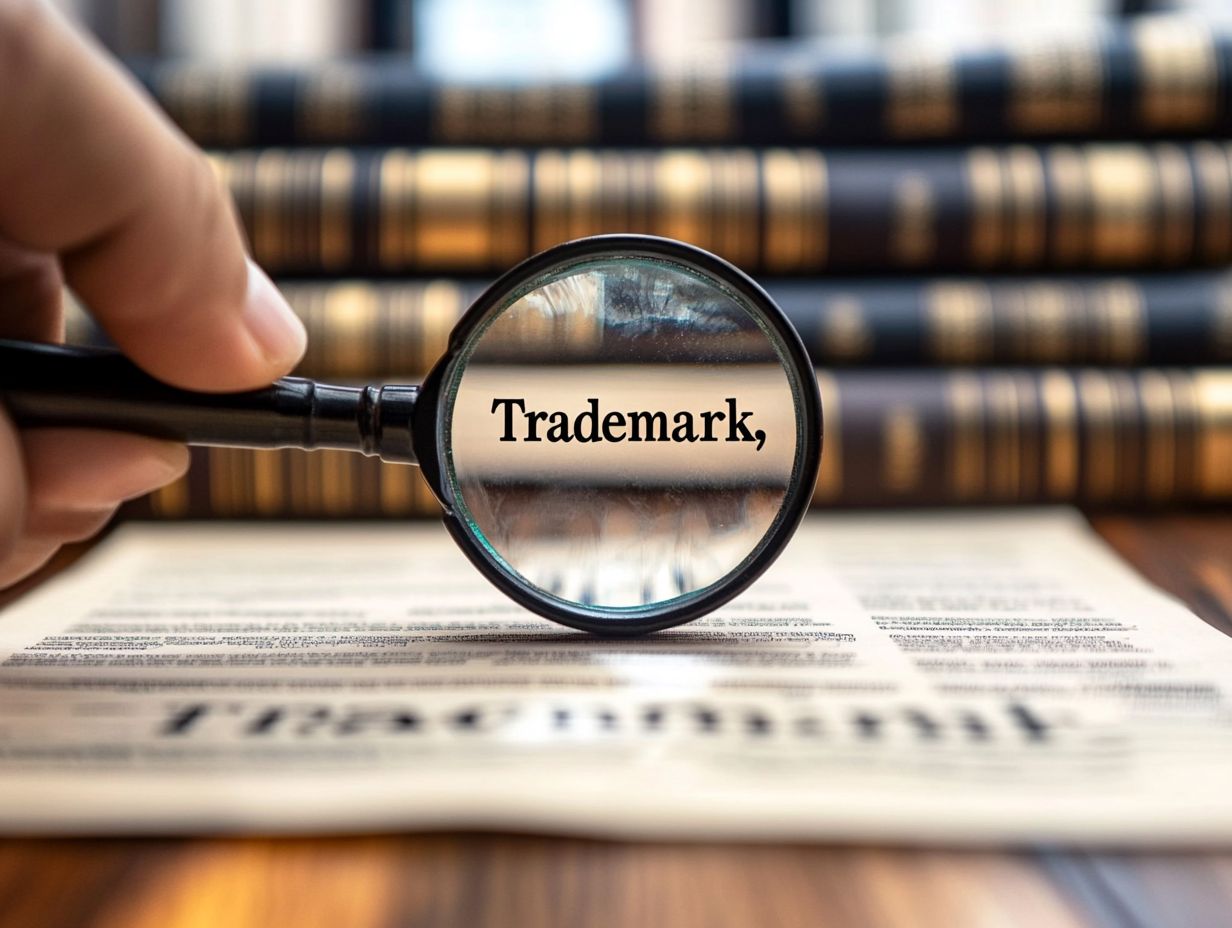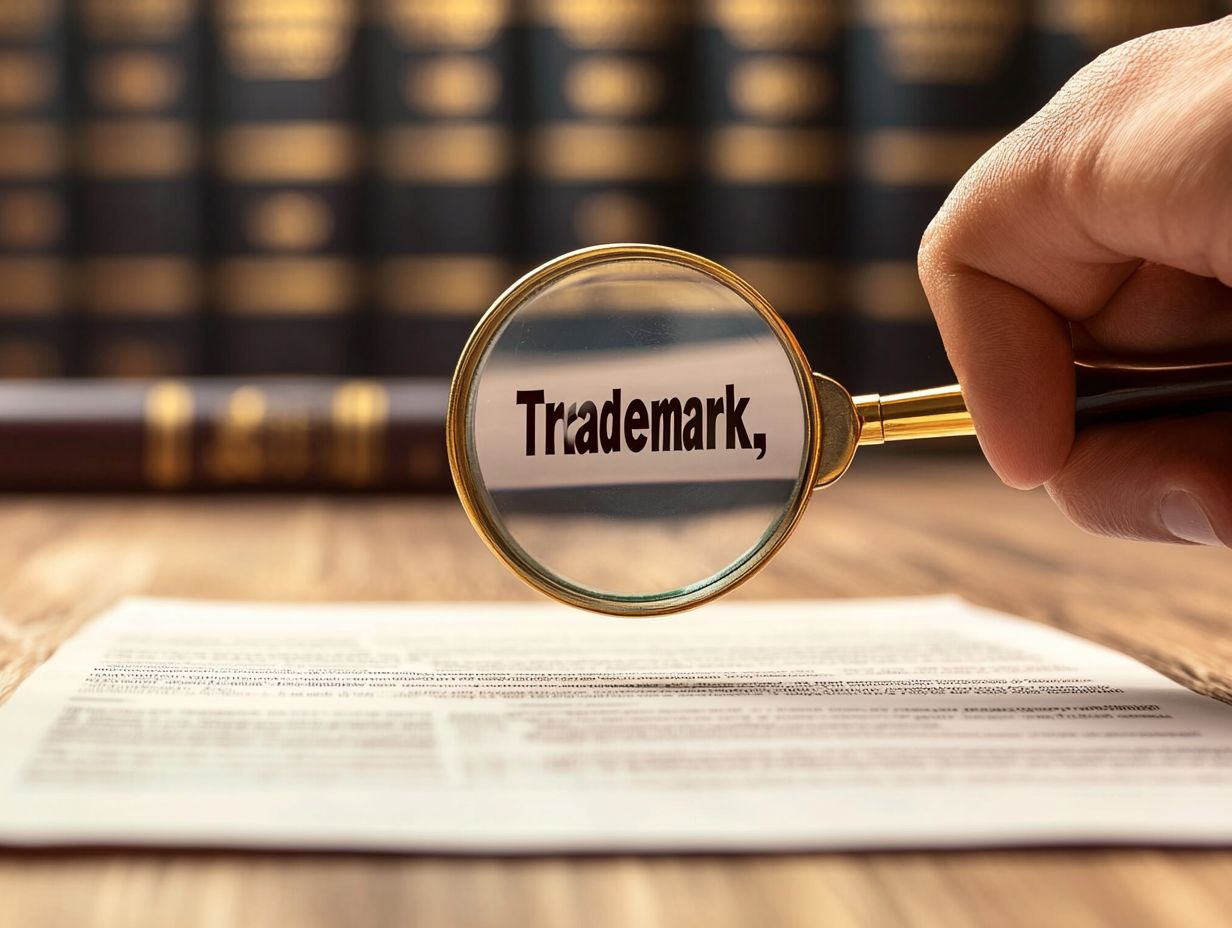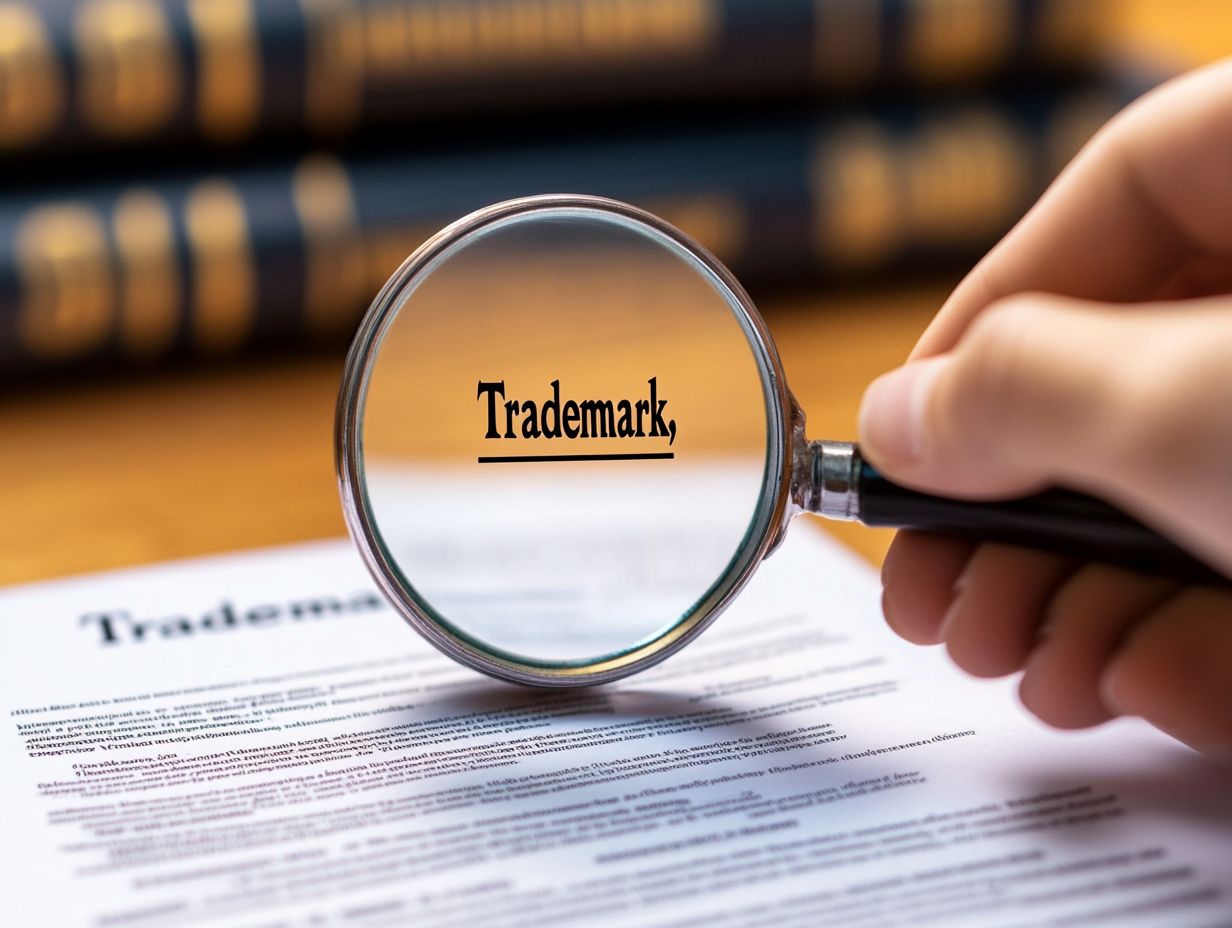How Does One Challenge a Trademark?
Trademarks are essential for safeguarding brand identity and fostering consumer trust.
So, what unfolds when a trademark faces a challenge? This article delves into the core aspects of trademarks, highlighting their importance and the various grounds for contesting them.
You ll uncover the steps involved in disputing a trademark, explore effective resolution methods, and discover how to protect your own trademark rights.
Whether you re a business owner or simply intrigued, this guide provides valuable insights into the complex realm of trademarks.
Contents
Key Takeaways:

- Trademarks are symbols or words that identify a brand and are crucial for brand recognition.
- Trademarks can be challenged if they are invalid or infringe on others.
- Steps include thorough research, filing a notice of opposition, and possibly mediation or legal action.
Understanding Trademarks
Understanding trademarks is vital for your business success! They serve as essential identifiers for your goods and services, granting you exclusive rights under a law that protects trademarks in the U.S.
Trademarks differentiate your products from those of your competitors and can manifest in various forms, from logos to brand names. Proper registration, or the process of officially securing your brand’s identity, with the U.S. Patent and Trademark Office (USPTO) not only secures these rights but also provides protection against infringement and misuse.
To keep your trademark safe, you must file necessary documents. This includes the Declaration of Use and Declaration of Incontestability, ensuring that your mark remains valid and protected in the marketplace.
What is a Trademark?
A trademark is a distinctive sign, design, or expression that sets apart the products or services of one source from those of others, all protected under the Lanham Act. Trademarks play a vital role in commerce by allowing you to easily identify the source of goods and services you’re purchasing.
This clarity not only fosters brand loyalty and trust but also helps to prevent confusion in a crowded marketplace.
Take the Nike swoosh, for example. It’s not just a logo; it represents quality athletic wear and a commitment to performance and style. It holds significant weight in the sports apparel industry. Similarly, the golden arches of McDonald’s do more than signal fast food; they evoke a sense of familiarity and convenience, making them instantly recognizable around the globe.
These symbols encapsulate the reputation and promise associated with their brands, illustrating how trademarks are essential in guiding your consumer choices.
Importance of Trademark Protection
Trademark protection is essential for your business, as it safeguards your rights against infringement and ensures that your brand identity remains both intact and exclusive in the marketplace.
By securing a trademark, you not only solidify your reputation but also cultivate customer trust. Consumers are far more likely to return to a brand that they recognize and feel confident in.
This protection gives you the power to act fast against unauthorized use, preserving the integrity of your brand and its offerings.
Understanding the implications of intellectual property laws is vital for any business owner. The trademark registration process typically requires thorough research to ensure your mark is unique, followed by an application with the relevant authorities, laying the foundation for lasting brand security.
Grounds for Challenging a Trademark
Challenging a trademark can arise from various grounds, such as claims of invalidity, infringement, or through opposition and cancellation proceedings at the Trademark Trial and Appeal Board (TTAB), as well as in federal court.
It is crucial for trademark owners to fully comprehend their rights in these scenarios.
Invalidity of Trademark

You can claim the invalidity of a trademark if the mark has changed into a generic name for the products or services it once represented. This makes it ineligible for legal protection.
This situation arises when a term or phrase, initially trademarked, loses its distinctiveness. It becomes widely recognized by the public as a common descriptor instead of an identifier for a specific source.
A classic example is “aspirin.” It was once a protected trademark but ultimately became synonymous with acetylsalicylic acid in various countries.
When you claim trademark invalidity, you will need to navigate a series of legal processes. Generally, you’ll need to demonstrate the mark’s generic status over time.
These cases can create significant implications. They can allow competitors to use the once-protected term freely, shifting market dynamics and altering consumer perceptions.
Infringement of Existing Trademark
Infringement occurs when you use a mark without authorization in a way that could confuse consumers. This may invite legal action from the trademark owner.
Confusion often stems from similarities in names, logos, or overall branding, leading consumers to mistakenly associate the unauthorized mark with the original brand.
Be aware of various types of trademark infringements:
- Direct infringement occurs when identical marks are used.
- Dilution can arise when a mark is tarnished or weakened by association with something lesser.
As a trademark owner, you can take legal steps to protect your brand. This might include cease-and-desist letters or formal lawsuits.
Numerous notable cases, such as Nike vs. Already LLC, underscore the gravity of trademark infringement. In these instances, courts have consistently ruled in favor of the established mark owner, highlighting the critical importance of safeguarding intellectual property rights.
Steps to Challenge a Trademark
Challenging a trademark requires a careful approach. Begin with comprehensive research and documentation to substantiate your claims.
After gathering your evidence, the next step is to file a Notice of Opposition with the Trademark Trial and Appeal Board (TTAB) or submit a petition in federal court. This systematic process ensures your challenge is well-founded and compelling.
Research and Documentation
Conducting thorough research and gathering necessary documentation are foundational steps in challenging a trademark. This ensures your claim is well-supported and clearly articulated.
Start by examining existing trademarks that are similar in nature, along with the relevant goods and services tied to those marks. Navigate trademark databases to identify potential conflicts and assess the distinctiveness of the trademarks at hand.
Careful documentation of your findings is crucial. Note down similarities and differences, existing usage in commerce, and geographical considerations that could impact the trademark s validity.
By systematically compiling this information, you create a robust factual basis that can significantly strengthen your case moving forward.
Filing a Notice of Opposition
Filing a Notice of Opposition with the TTAB is your formal route to contest the registration of a trademark. You can base your challenge on various grounds like likelihood of confusion, prior use, or even genericness.
This process requires you to submit the appropriate forms within a specific timeframe, typically 30 days from when the trademark is published in the Official Gazette. It s essential to clearly identify your basis for opposition.
This might involve presenting evidence of existing trademarks that could lead to confusion or demonstrating that the trademark in question is generic and thus not entitled to protection.
When preparing an effective opposition, gathering thorough documentation is key. Articulate your arguments clearly and seek legal advice to bolster your case if feasible.
Ensure that all your submissions are timely and comprehensive. This will significantly influence the outcome of the opposition process.
Don t let a generic term steal your trademark! Act quickly to protect your brand!
If you need assistance, consider consulting a trademark attorney to navigate this complex process.
Resolving a Trademark Dispute

Resolving a trademark dispute offers several strategic options.
You can choose mediation or negotiation for a collaborative atmosphere. Alternatively, you may pursue litigation in federal court.
Each approach has its implications, influencing the resolution process and outcomes.
Mediation and Negotiation
Mediation and negotiation are often preferred for resolving trademark disputes. They help achieve amicable agreements without the high costs of litigation.
These processes focus on collaboration and open communication. You and the other party can effectively share your concerns and desires.
A neutral third party guides mediation discussions. This helps both sides find creative solutions that might be missed in court.
Effective communication strategies like active listening can improve your chances of a satisfying resolution.
Notable companies like Apple and Samsung have used mediation to settle trademark issues. This approach saved them resources and maintained business relationships.
Legal Action and Litigation
When mediation fails, legal action is necessary to resolve the dispute. Litigation in federal court involves both parties presenting their arguments.
The process begins with the plaintiff filing a complaint detailing their claims. The defendant then responds to this complaint.
Next is the discovery phase, where both sides gather evidence. Pre-trial motions may be filed to dismiss claims or seek summary judgment during this time.
If the case reaches trial, each party presents their arguments to a judge or jury. They will then render a verdict with possible outcomes like damages, injunctions, or affirmations of trademark rights.
High-profile cases, such as Coca-Cola’s dispute with the Coca-Cola Company of India, highlight how litigation impacts brand identity and market presence.
Protecting Your Own Trademark
Protecting your trademark is vital for your brand identity. This includes proper registration and vigilant enforcement against infringement.
By taking these steps, you ensure your brand remains uniquely yours in the market.
Trademark Registration and Maintenance
Trademark registration is the cornerstone of brand protection. This requires submitting essential documents and maintaining your trademark s validity.
Your journey starts with identifying the correct type of trademark. It could be a word mark, design mark, or service mark, each serving a unique purpose.
You must carefully navigate classifications of goods and services. This ensures your trademark is applied within the correct international classes.
After registration, remain vigilant about ongoing maintenance. Trademarks need renewals and specific filings to ensure continued protection.
Understanding these critical steps secures your brand s visibility and precedence in the market.
Enforcing Your Trademark Rights

Enforcing your trademark rights is crucial. It helps prevent infringement and safeguards your brand.
You should first familiarize yourself with your trademarks. Actively monitor the marketplace for similar marks.
Conduct online searches or use professional services to watch for potential infringements.
If you spot infringements, document everything meticulously. Note the infringing parties and instances of use.
When you have a clear case, strategies can vary. You might initiate negotiations or pursue formal litigation.
Successful cases highlight the need for strong enforcement strategies.
Frequently Asked Questions
How Does One Challenge a Trademark?
To challenge a trademark, one must file a trademark opposition with the United States Patent and Trademark Office (USPTO) within 30 days of the trademark publication date.
What is a trademark opposition?
A trademark opposition is a legal process. It allows someone to contest a trademark they believe might confuse consumers.
Who can challenge a trademark?
Any party who believes that a trademark may cause confusion with their own trademarks can file a trademark opposition, including individuals, businesses, and organizations.
What are the grounds for challenging a trademark?
The grounds for challenging a trademark include likelihood of confusion with an existing trademark, weakening the trademark’s identity, false or misleading information, and generic or descriptive use.
What is the process for challenging a trademark?
The process for challenging a trademark involves filing a Notice of Opposition with the USPTO, conducting discovery, submitting evidence, and attending a trial before the Trademark Trial and Appeal Board (TTAB). For those interested in intellectual property, understanding how to contest a patent can also be beneficial.
What happens if a trademark is successfully challenged?
If a trademark is successfully challenged, the USPTO may refuse to register the trademark or cancel an existing trademark registration. The party who filed the opposition may also be able to obtain damages or injunctive relief from the trademark owner.






